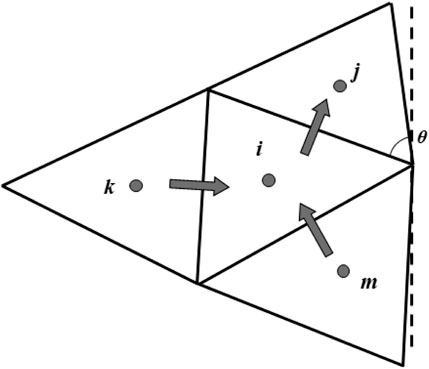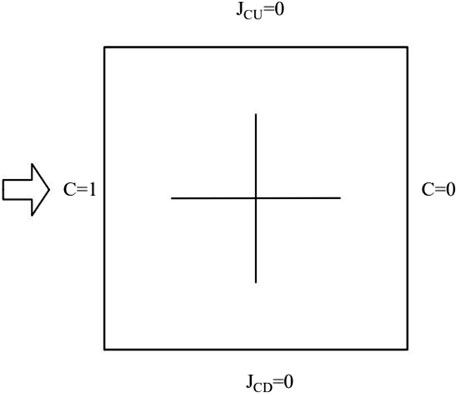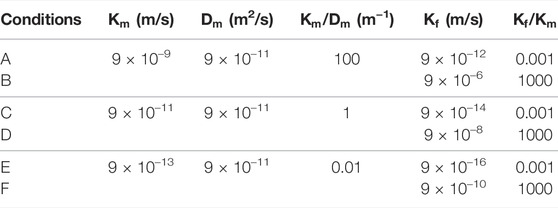- 1State Key Laboratory of Geomechanics and Geotechnical Engineering, Institute of Rock and Soil Mechanics, Chinese Academy of Sciences, Wuhan, China
- 2University of Chinese Academy of Sciences, Beijing, China
- 3GeoRessources Laboratory, UMR 7359, CNRS, Vandœuvre-lès-Nancy, France
- 4Management Department High Level Radwaste Disposal Safety Division, China Institute for Radiation Protection, Taiyuan, China
- 5School of Civil and Architectural Engineering, Wuhan University, Wuhan, China
A core concern in the research on deep geological disposal of high-level radioactive waste is the migration of radionuclides in geological bodies. Most studies on radionuclide migration consider the role of only the rock fissures without incorporating the influence of the rock matrix. In this paper, the rock mass for geological disposal of high-level radioactive waste is regarded as a fissure-pore medium. Considering the influences of radionuclide diffusion and fluid transport on radionuclide migration in the process of disposal, the governing equation of radionuclide migration and evolution in the pore-fissure medium is established. The numerical scheme of the governing equation is given based on the mixed finite volume method (FVM), using our program solution module written in C++. On this basis, the numerical test model with fissures was developed, which analyzed the radionuclide migration law in clayey rocks under various fissure and rock matrix diffusion coefficients and hydraulic conductivities. The simulation results are compared with finite element method results, revealing the superiority of the mixed FVM method in solving problems of radionuclide migration in discontinuous geological bodies containing hiatuses, mutations, and fissures. The study provides a theoretical basis for evaluating the safety, feasibility, and suitability of geological disposal repositories for high-level radioactive waste in terms of radionuclide migration.
1 Introduction
During the operation and closure of geological repositories for high-level radioactive waste, the stored nuclear waste continuously releases radionuclides with long half-lives, strong radioactivity, and high toxicity (IAEA, 2010; Cho et al., 2012; Wu, 2017). The design life of a geological repository for high-level radioactive waste is typically tens of thousands of years. On such a long time scale, the artificial engineering barriers, e.g., nuclear waste packaging, buffer layers, and surrounding rocks and linings, are likely to experience damage and failure. Coupled with geological structuring, radionuclides may leak and migrate to surrounding rocks and the biosphere of the repository (Martin et al., 2009; Grupa et al., 2017). Once the radionuclides enter the ecosystem, they can cause irreversible radioactive damage and possibly threaten the lives of humans and other organisms (Labib and Harris, 2015; L’Annunziata, 2016; Ahmad et al., 2019). Therefore, one core challenge in the safety evaluation of radioactive waste disposal is to quantitatively evaluate the migration law of radionuclides with underground water and other carriers.
With low permeability, strong retardation to radionuclide migration, and self-sealing properties, clayey rocks are considered reasonable geological barriers for high-level radioactive waste disposal (Yu et al., 2018; 2021). Countries like Switzerland, France, and Belgium have selected clayey rock as a candidate for geological disposal repositories of high-level radioactive waste. They conducted significant research and development on clayey rock site screening and feature evaluation and built underground clayey rock laboratories (Van Marcke et al., 2010; Jacops et al., 2015; Bossart et al., 2017; Leupin et al., 2017; Wigger et al., 2018).
The clayey rock surface, which generally exhibits electronegativity, is prone to adsorb cations with strong electrophilicity. Nuclides with weak electrophilicity and anionic nuclides do not tend to be adsorbed on the clay surface, and their diffusion is relatively fast (Van Loon et al., 2007). For radionuclides with strong radioactivity, high toxicity, and long half-lives, the question arises of whether multiple barriers can effectively prevent them from migrating to the biosphere during a long process of geological disposal. Van Loon et al. (2005) studied the diffusion behavior of some key elements (e.g., tritiated water (HTO), Cl−, Na+) in clayey rocks, e.g., Opalinus Clay, using the diffusion cell method and obtained many migration parameters. In another study, Leupin et al. (2017) presented the research results of the Mont Terri Laboratory about material migration in Opalinus Clay in the last 20 years, which provided valuable data for the safety evaluation of underground laboratories and disposal repositories in Switzerland. Additionally, Jacops et al. (2015; 2017) studied the diffusion coefficients of dissolved gas and HTO in Boom clayey rocks by the diffusion cell method, providing a useful experimental basis for the construction of disposal repositories in Belgium. Bazer-Bach et al. (2006) provided evidence of a kinetically limited slight retention of iodide in Callovo-Oxfordian argillites at low total iodine concentration through batch experiments. Further research by Altmann et al. (2012) addressed the migration and diffusion of radionuclides from clayey rocks in the geological nuclear waste repository to the biosphere. These data of diffusion-driven transfer in strata revealed extreme differences in the measurements or simulated behaviors of various radionuclides, which were mainly due to the varying effects of halogen elements on diffusion and adsorption. Some progress has been made in the study of radionuclide migration laws in clayey rocks. However, radionuclide migration is time-consuming and slow in transformation, so some mechanisms and laws require further investigations for a better understanding.
After lengthy diagenesis and tectonic movement, the clayey rock mass inevitably contains many pores and micro-fissures, and the deep geological disposal repository for radioactive waste depends on just this geological body. Conventionally, the migration mechanisms of nuclides in fissured rocks focus on diffusion, convection, adsorption, and retardation, without considering the influence of pores. In fact, pores, comprising a typical non-connecting factor, form the fissure-pore permeability channel together with fissures. Fissure fillings and rock matrixes with various hydraulic properties are often encountered in the geological disposal of radioactive waste. When the permeability of the filling is better than that of the rock matrix, the network composed of random fissures will form dominant water channels and control the overall seepage field and radionuclide migration of the geological body. When the hydraulic conductivity of the filling is lower than that of the rock matrix, the fissure network will form an obstacle into shielding seepage. Under this circumstance, the rock matrix where the pores are located controls the overall seepage field, and the filling becomes a low-permeability barrier, hindering the migration of radionuclides in the geological body.
Conventional fissure medium models only consider the mechanical and seepage characteristics of fissures, ignoring the role of the rock matrix. In most cases, the fissure surface aperture of the fissured rock mass is relatively large, maintaining good water conductivity, and the fillings contain mostly rock and soil materials with good permeability, e.g., weathered sediments. The water conductivity of the fissure is better than that of the rock matrix (Zhang et al., 2012; Tran et al., 2021), so the role of the rock mass can be neglected in the numerical model. However, when studying the geological disposal of high-level radioactive waste, the influence of the rock matrix cannot be ignored in the simulation, and the numerical method for the fissure-pore medium becomes necessary. The main difference between this method and conventional porous medium methods is that the former considers the fissure–fissure and fissure–rock matrix flow exchanges in numerical discretization.
Currently, fluid migration simulation in fissure-pore media is mostly based on the finite volume method (FVM) or its improved versions. Among the various versions, the cell-centered FVM (CFVM) is the most widely used (Nordbotten, 2014), in which two major approaches have been formed: embedded discrete fissure model (EDFM) (Tene et al., 2017) and discrete fissure model (DFM) (Mohammad and Abbas, 2003). They adopt different mesh generation methods and discretization methods and have their respective advantages and disadvantages. Specifically, EDFM adopts an orthogonally structured mesh generation, whereas DFM uses a more complex non-structured triangular mesh. The mesh of EDFM enables weak mesh dependence, which saves time and energy in mesh processing. However, because it uses the transfer function to simulate the flow exchange between the fissure and rock matrix, its accuracy is lower than that of the DFM method. The DFM method uses a more accurate conforming mesh and addresses the flow exchange problem through the pressure gradient of nodes and cells. It takes the fissure surface as the constraint boundary of meshing and calls the constrained Delaunay algorithm to realize a non-structured mesh generation (Mustapha, 2014). The DFM method is applicable to both CFVM (Nordbotten, 2014) and nodal-based FVM (NFVM) (Amaziane et al., 2009). To the best of the author’s knowledge, however, publications on radionuclide migration analysis have rarely used the mixed FVM.
In this paper, the evolution of radionuclide migration in the fissure-pore medium is systematically studied by the mixed FVM. The numerical discretization steps and program module are introduced, with the program solution module independently written in C++ to analyze the diffusion, fluid migration, and decay of radionuclides in clayey rocks and their migration under adsorption and retardation of the rock matrix. This study can provide a theoretical basis for evaluating the safety, feasibility, and suitability of geological disposal repositories for high-level radioactive waste in terms of radionuclides migration.
2 Radionuclide Migration Law Considering Diffusion
2.1 Theory of Radionuclide Migration Considering Diffusion
Similar to the governing equations of heat conduction and fluid migration, the migration of nuclides in the rock matrix is governed by mass conservation and satisfies a hyperbolic partial differential equation (PDE):
where
The flow
where
where
Substituting Eq. 2 into Eq. 1 Obtains
Equation 4 is the governing equation of radionuclide migration considering only diffusion, which is applicable to the diffusion of nuclides without decay or with a research time scale significantly smaller than the nuclide half-life, without considering fluid migration and adsorption of the fissure-pore medium.
The initial boundary values of the PDE system need to be given at the boundary
where
When accounting for the influence of natural pores, the pores can be set to be filled or not. When the pores are filled, the filling material can be given various diffusion properties with the option to define as a special fissure or matrix in the numerical processing. When the pores are not filled, the boundary can be treated as a special internal boundary, for which only the corresponding conditions need to be added to the solution.
2.2 Numerical Scheme
According to the basic principle of the FVM method, Eq. 4 is integrated within the whole spatial domain
where
The first term on the left side of Eq. 7 represents the time discretization, the second term is the diffusion, and the right-hand side is the source-sink term. Considering model establishment and mesh generation, the total number of cells in the region is denoted as
where
Eq. 8 is applicable to radionuclide migration in the fissure-pore medium considering diffusion. To transform the semi-discrete scheme of Eq. 8 into a fully discrete one, the field variable is interpolated to find a solution
The CFVM has a piecewise-continuous interpolation function and, therefore, is regarded as a special finite element method (FEM). The numerical solution aims to solve the governing equation and the unknown concentration field variable
Therefore, the concentration at any point in the domain can be solved by Eq. 9. The shape function
The shape of the piecewise interpolation function
Substituting Eq. 9 for the field variable to be solved in Eq. 8, transforming the volume integral of the diffusion term into a surface integral through the Gauss’s formula, and considering the spatial discretization, the fully discrete scheme of the mixed FVM for radionuclide migration simulation in the fissure-pore medium considering only diffusion can be obtained as
where
where
where
where
Figure 1 displays a possible case of flow exchange. Taking the flow transport between
where
Comparing Eqs 12, 14, 16, the comprehensive diffusion coefficient
The concentration transfer coefficient
Equation 17 degenerates into a case of isotropy when
2.3 Program Implementation
The numerical discretization method for simulating radionuclide migration in the fissure-pore medium by mixed FVM considering only diffusion is thoroughly described in the previous sections. The key challenge of numerical implementation is the use of explicit iteration to handle the time term in the governing equation and the diffusion material flow exchange between the fissure and rock mass. This section introduces the radionuclide migration simulation program. The main modules of numerical simulation for the fissure-pore medium are the following: (1) pre-processing (the generation of fissure and matrix cells using the ABAQUS pre-processing module), (2) the assembly of the diffusion and migration governing equations (based on mixed FVM), (3) iterative calculation in time steps, and (4) post-processing (using Paraview).
The heterogeneous diffusion coefficient can be considered in the simulation of radionuclide migration by assigning various diffusion coefficients to the fissure and rock matrix cells. Anisotropic diffusion coefficients (
2.4 Example Analysis
This section explains how our developed mixed FVM program was analyzed through the numerical test model of clayey rocks with orthogonal fissures, as displayed in Figure 2. The model was a square with a side length of 9 m, in the middle of which were two orthogonal fissures. Each fissure was 5 m long and 0.1 m wide. The left boundary of the model was where the nuclides were injected, so the concentration was maintained at
Various studies have been conducted to obtain the diffusion coefficient for the migration of radionuclides through the host rock. Meeussen et al. (2017) estimated the pore diffusion coefficient of Boom Clay, which was in the range of 5.7 × 10–12 to 8.5 × 10–9 m2/s. When setting the arbitrary test values for the compartments’ waste and host rock (Boom Clay) radionuclides used in the benchmark calculations, Grupa et al. (2017) chose 2.0 × 10–10 m2/s for the diffusion coefficient. Based on diffusion experiments, Bucur et al. (2000) found that the diffusion coefficient of main radionuclide CS-137 and \Co-60 ranged from 9.89 × 10−9–6.5 × 10–8 m2/s and 7.59 × 10−9–4.94 × 10–8 m2/s, respectively, in red clay with a higher montmorillonite content.
Here, we chose
The mixed FVM adopted a total of 1670 triangular cells, and 441 DC2D4 cells were used in ABAQUS. The mass diffusion (transient) analysis step was used for the calculation, the total time was set to 1.5763 × 1010 s (500 years), and the initial and maximum time increment step was set to 3.1536 × 107 s (1 year). The simulation results of the mixed FVM method were visualized through the open-source software Paraview, and the ABAQUS simulation results were displayed through the ABAQUS/CAE post-processing module, as presented in Figures 3–5. ABAQUS allowed the “Monitor” function for dynamic monitoring in the calculation. When the time interval of each ABAQUS step in the implicit iterative calculation was 3.1536 × 107 s (1 year), convergence was possible. Considering the boundary conditions, internal concentration field distribution, and the concentration change of each time increment step, the time increment
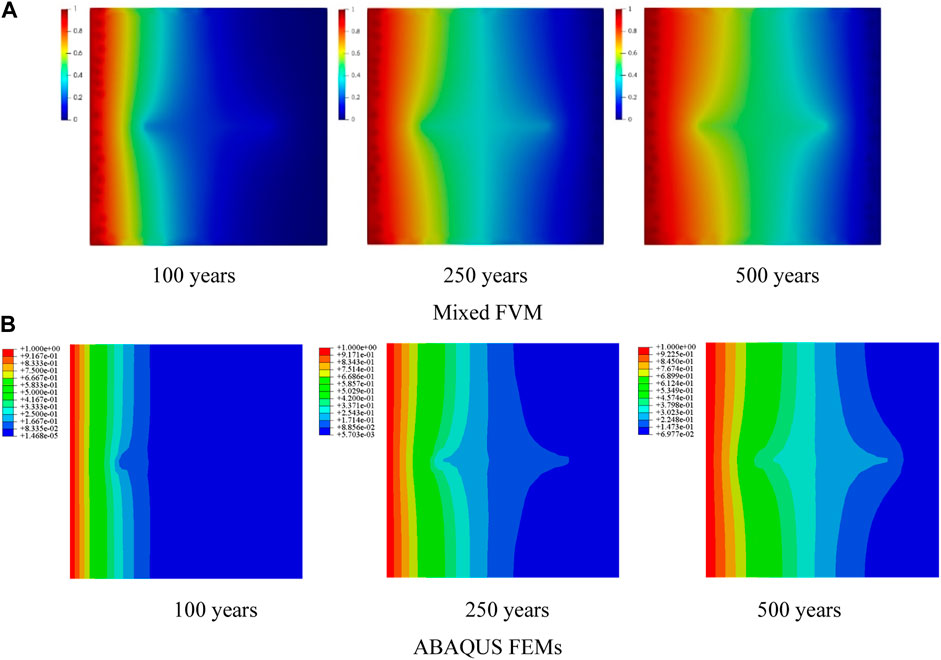
FIGURE 3. Comparison of the mixed FVM and ABAQUS FEMs under Condition A (
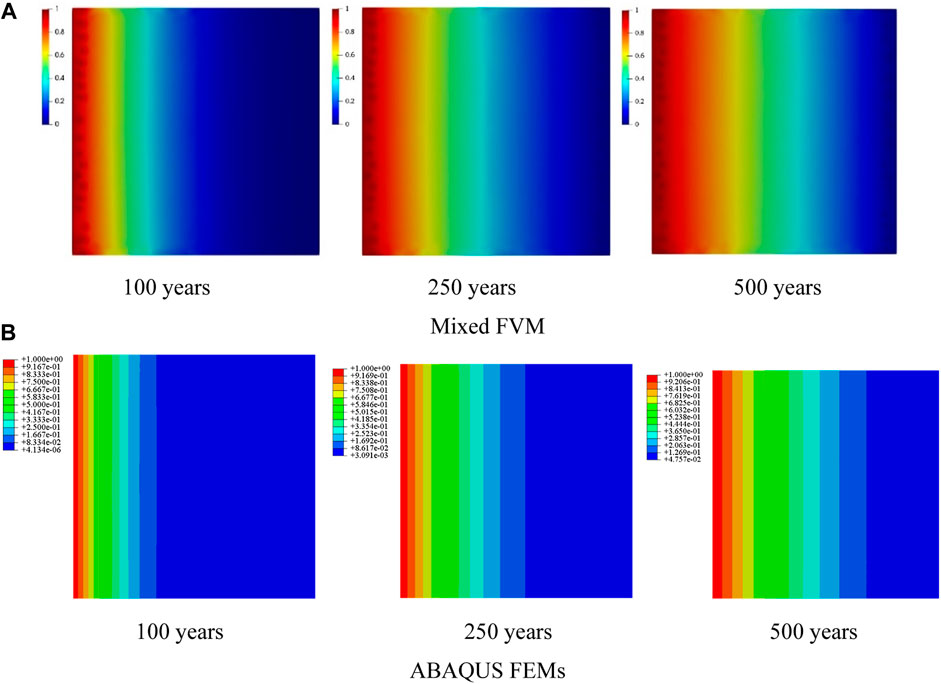
FIGURE 4. Comparison of the mixed FVM and ABAQUS FEMs under Condition B (

FIGURE 5. Comparison of the mixed FVM and ABAQUS FEMs under Condition C (
The residual of each time step is defined as
where
For a single rock matrix cell
In addition, for a single rock fissure cell
where
The numerical test results revealed that the nuclide concentration distributions in the matrix calculated by mixed FVM and ABAQUS were roughly the same, though a large difference was present around the fissures:
(a) For
(b) For
(c) For
3 Radionuclide Migration Law Considering Fluid Transport
3.1 Theory of Radionuclide Migration Considering Fluid Transport
The migration of nuclides in underground rocks is often accompanied by the migration of groundwater, so the convection term needs to be added to the governing equation:
The third term on the left side of Eq. 22 can be equivalent to:
In a stable flow field, assuming that the fluid is incompressible and the divergence of fluid velocity is zero. That is to say
where
where
where
Equation 24 is the convection term of the governing equation considering fluid transport. Otherwise, the boundary conditions and the scheme accounting for the influence of pores are consistent with those introduced in Section 2.1 Eq. 24 can describe the diffusion and migration of nuclides under fluid transport without decay or with a research time scale much smaller than the nuclide half-life, such as the migration of nuclides in rock matrixes containing groundwater, in the atmosphere (Ge et al., 2021), and with the ocean current in coastal areas (Li et al., 2020).
3.2 Numerical Scheme
According to the basic principle of FVM, Eq. 24 is integrated over the whole spatial domain
The time term of Eq. 28 is discretized numerically. From Section 2.4, the explicit iteration algorithm is relatively simple and easy to implement. This highly efficient calculation achieves accuracy without solving the equations in each time increment step. Therefore, this section also adopts explicit iteration to approximate Eq. 28:
The first term on the left side of Eq. 29 is the time-discrete term, the second term represents diffusion, the third term is convection, and the right-hand side is the source-sink term. Considering model establishment and mesh generation (the total number of cells is
The shape function
where
The penetration rates
The residual of each time iteration step can be defined as:
For a single rock matrix cell
For a single rock fissure cell
where
3.3 Program Implementation
The numerical discretization methods for simulating radionuclide migration in the fissure-pore medium by mixed FVM considering diffusion and fluid transport have been introduced in the previous sections. This section discusses the simulation program. The radionuclide migration simulation program module was independently developed in C++. When accounting for the effect of the seepage field, the time scale of the seepage pressure is extremely small compared to that of radionuclide migration because it propagates in the form of a pressure wave. Therefore, in the numerical solution, the two activities can be separated by sequential decoupling. In other words, the distribution of osmotic pressure can be solved first, and then the distribution of the concentration field under fluid transport can be solved by the convection term in the governing equation.
The main modules of fissure-pore medium simulation are (1) pre-processing (fissure and matrix cells are divided using the ABAQUS pre-processing module), (2) the assembly and solution of the seepage governing equation matrix (based on mixed FVM), (3) the assembly of the diffusion and migration governing equation matrix (based on mixed FVM, considering the influence of the seepage field), (4) iteration in time steps, and (5) post-processing (using Paraview). The fissure-pore medium modeling and cell division in pre-processing are conducted in the ABAQUS pre-processing module. The radionuclide migration simulation program in this section can account for cases of homogeneous or heterogeneous properties, isotropic or anisotropic diffusion, and permeability. Each cell in the fissure and rock matrix is assigned with diffusion and hydraulic conductivities corresponding to the required research condition. The physical essence of this process is material transport, the most prominent features of which are time and flow dependencies, as reflected by the time term
3.4 Example Analysis
3.4.1 Validation of the Mixed FVM Program
Our mixed FVM program was analyzed through the numerical test model of a clayey rock with two vertical fissures, as displayed in Figure 6, and validated with the calculation results of Yan et al. (2020). The model was a square with a side length of 0.1 m. The length of both fissures was 0.02 m, and the width was 0.002 m. The left boundary of the model was set as the nuclide injection position, where the concentration was maintained at
The mixed FVM adopted 1261 triangular cells, and the total time was set to 1.728 × 107 s (200 days). The time increment

FIGURE 7. Comparison of the mixed FVM and FEMs.(A) Mixed FVM (B) FEMs (Yan et al., 2020)
The numerical results revealed that the radionuclides moved from left to right under the influence of diffusion and fluid transport, and the concentration field distributions calculated by the two methods were roughly the same, which indicated the accuracy and effectiveness of the mixed FVM program. Because the fissure had diffusion- and seepage-insulation properties, the fissure hindered the migration of materials and affected the concentration field distribution in the whole region. Especially on both sides of the fissure, a step-change in the concentration field was present. To enhance the finite element calculation results, Yan et al. (2020) hollowed the fissure part. Using the mixed FVM, however, the step-change in concentration could be observed clearly without subsequent treatment. Therefore, the mixed FVM more effectively describes discontinuous media involving hiatuses, mutations, and fissures.
3.4.2 Effect of Hydraulic Conductivity on Radionuclide Migration
For the model shown in Figure 6, the mixed FVM method adopted triangular cells to study the influence of rock matrix and fissure permeability on radionuclide migration. The diffusion and hydraulic conductivities used in the simulation are displayed in Table 1. The total time was set to 1.728 × 108 s (2,000 days), and the other parameters and boundary conditions were the same as those in Section 3.4.1.
By comparing the distribution patterns of radionuclide migration concentration under various conditions as in Figure 8, the following conclusions could be drawn:
(a) Under Conditions A and B in Figures 8A,B, where
(b) Under Conditions C and D in Figures 8C,D, where
(c) Under Conditions E and F in Figures 8E,F, where
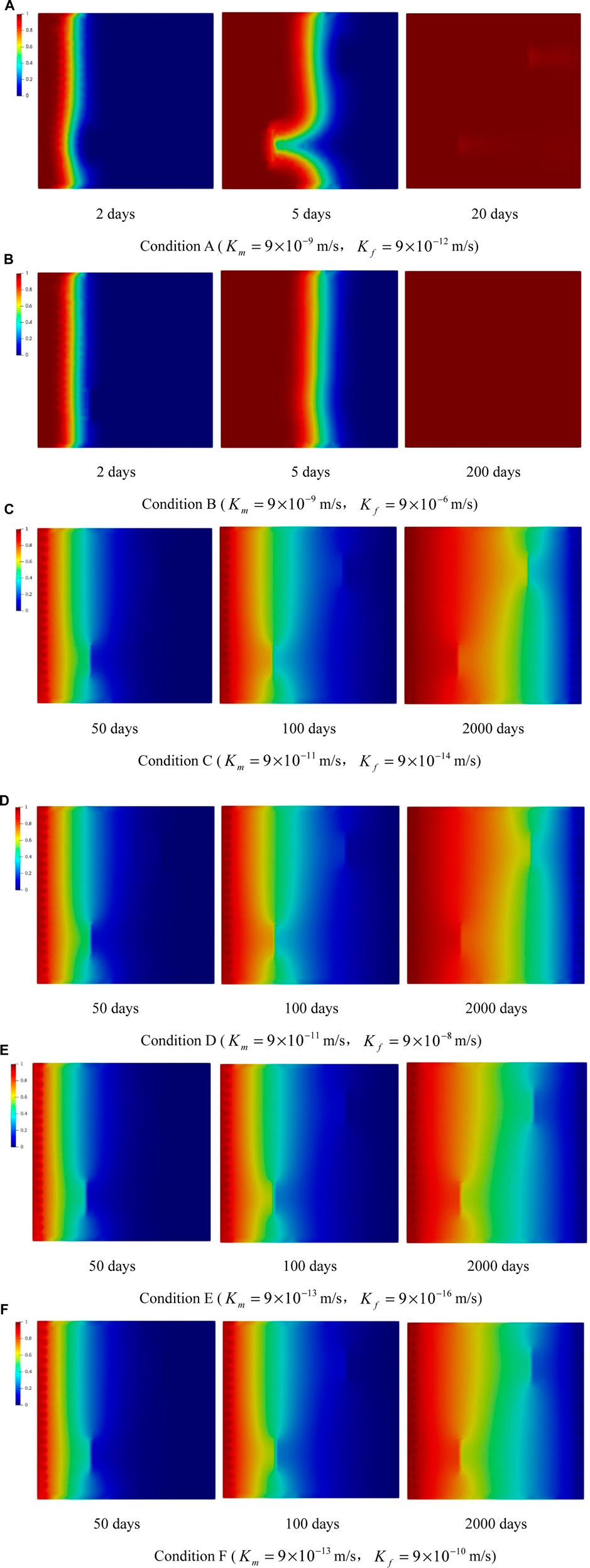
FIGURE 8. (Continued). Distribution pattern of radionuclide migration concentration under various conditions. (A) Condition A (
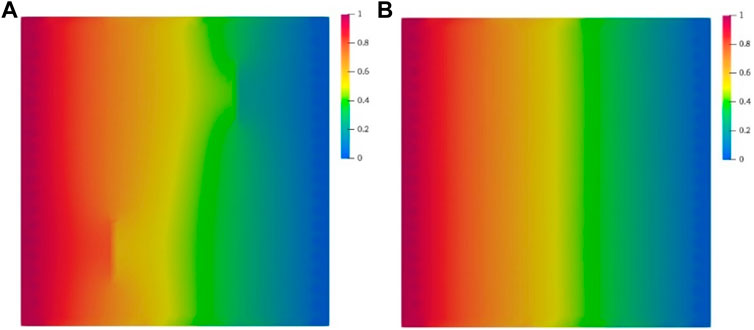
FIGURE 9. Distribution pattern of water pressure under Conditions A and B. (A) Condition A, (B) Condition B.
4 Conclusion
In this paper, the rock mass around the geological disposal repository for high-level radioactive waste was regarded as a fissure-pore medium to determine the influences of nuclide diffusion and fluid transport on radionuclide migration in the rock mass during high-level radioactive waste disposal. The governing equation of radionuclide migration and evolution in the pore-fissure medium is established. The corresponding numerical scheme is given based on the mixed FVM method, using our program solution module written in C++. On this basis, a numerical test model containing fissures was established to analyze the nuclide migration process in the clayey rock under various fissure and rock matrix diffusion conditions. The comparison of the effects of the rock matrix and fissure hydraulic conductivities on radionuclide migration yielded the following conclusions. When fluid transport dominated in radionuclide migration, the radionuclide migration rate was high, and the distribution of concentration field in the migration process was greatly affected by the permeability difference between the fissure and the rock matrix. When the fluid transport and diffusion effects were comparable or when the diffusion played a major role, the radionuclide migration rate decreased. Additionally, the permeability difference between the fissure and the rock matrix had little impact on concentration field distribution in the process of diffusion migration. The comparison between the mixed FVM and the finite element methods using ABAQUS revealed significant advantages of the mixed FVM method in describing discontinuous media involving hiatuses, mutations, and fissures. By changing the parameters such as diffusion and hydraulic conductivities, the method can be applied in the study of radionuclide migration laws in other geological bodies with high-level radioactive waste. This study will provide an important scientific basis for the failure analysis of the geological disposal of HLW.
Data Availability Statement
The original contributions presented in the study are included in the article/supplementary material, further inquiries can be directed to the corresponding authors.
Author Contributions
HY: Conceptualization, Investigation, Formal analysis, Supervision, Funding acquisition, Writing–original draft, Writing–review and editing. CL: Investigation, Data curation, Formal analysis, Writing–original draft, Writing–review and editing. WC: Conceptualization, Project administration, Funding acquisition, Writing–original draft, Writing–review and editing. LW: Resources, Writing–original draft, Writing. HoL: Supervision–review and editing. HaL: Funding acquisition, Writing–original draft, Writing–review and editing.
Funding
The financial support of the National Natural Science Foundation of China (No. 51979266, 51879258, and 51974203) is greatly acknowledged.
Conflict of Interest
The authors declare that the research was conducted in the absence of any commercial or financial relationships that could be construed as a potential conflict of interest.
Publisher’s Note
All claims expressed in this article are solely those of the authors and do not necessarily represent those of their affiliated organizations, or those of the publisher, the editors and the reviewers. Any product that may be evaluated in this article, or claim that may be made by its manufacturer, is not guaranteed or endorsed by the publisher.
Acknowledgments
Appreciations are extended to Sweetland K and Yu Y, who have given valuable suggestions and worked hard on improving the English of this article.
References
Ahmad, A. Y., Al-Ghouti, M. A., AlSadigAbu-Dieyeh, I. M., and Abu-Dieyeh, M. (2019). Vertical Distribution and Radiological Risk Assessment of 137Cs and Natural Radionuclides in Soil Samples. Sci. Rep. 9, 12196. doi:10.1038/s41598-019-48500-x
Altmann, S., Tournassat, C., Goutelard, F., Parneix, J.-C., Gimmi, T., and Maes, N. (2012). Diffusion-driven Transport in Clayrock Formations. Appl. Geochem. 27 (2), 463–478. doi:10.1016/j.apgeochem.2011.09.015
Amaziane, B., Bergam, A., El Ossmani, M., and Mghazli, Z. (2009). A Posterioriestimators for Vertex Centred Finite Volume Discretization of a Convection-Diffusion-Reaction Equation Arising in Flow in Porous Media. Int. J. Numer. Meth. Fluids 59 (3), 259–284. doi:10.1002/fld.1456
Bazer-Bachi, F., Tevissen, E., Descostes, M., Grenut, B., Meier, P., Simonnot, M. O., et al. (2006). Characterization of Iodide Retention on Callovo-Oxfordian Argillites and its Influence on Iodide Migration 31(10-14), 517–522. doi:10.1016/j.pce.2006.04.015
Bossart, P., Bernier, F., Birkholzer, J., Bruggeman, C., Connolly, P., Dewonck, S., et al. (2017). Mont Terri Rock Laboratory, 20 Years of Research: Introduction, Site Characteristics and Overview of Experiments. Swiss. J. Geosci. 110, 3–22. doi:10.1007/s00015-016-0236-1
Bucur, C., and Popa, A. (2000). Diffusion Coefficients of Critical Radionuclides from Radioactive Waste in Geological MediumWM’00 Conferencrsene, C., and Olteanu, M. Tucson, AZ. February 27 – March 2, 2000.
Cho, W.-J., Lee, J.-O., and Choi, H.-J. (2012). Radionuclide Migration through an Unsaturated Clay Buffer under Thermal and Hydraulic Gradients for a Nuclear Waste Repository. Ann. Nucl. Energy 50, 71–81. doi:10.1016/j.anucene.2012.07.010
Ge, B. Z., Lu, Q. Q., Chen, X. S., and Wang, Z. F. (2021). A Review of the Numerical Simulations of the Atmospheric Dispersion of Radionuclides[J]. Acta Sci. Circumstantiae 41 (5), 1599–1609.
Grupa, J.,B., Meeussen, J. C. L., Rosca-Bocancea, E., Buhmann, D., Laggiard, E., and Wildenborg, A. F. B. (2017). Migration of Radionuclides in Boom Clay PA Model 'Clay'. Report. Vlissingen, Netherlands: OPERA-PU-NRG7212.
IAEA (2010). Production of Long Lived Parent Radionuclides for Generators: 68Ge, 82Sr, 90Sr and 188W. IAEA Radioisotopes and Radiopharmaceuticals Series No. 2. Vienna, Austria: International Atomic Energy Agency VIENNA.
Jacops, E., Aertsens, M., Maes, N., Bruggeman, C., Krooss, B. M., Amann-Hildenbrand, A., et al. (2017). Interplay of Molecular Size and Pore Network Geometry on the Diffusion of Dissolved Gases and HTO in Boom Clay. Appl. Geochem. 76, 182–195. doi:10.1016/j.apgeochem.2016.11.022
Jacops, E., Wouters, K., Volckaert, G., Moors, H., Maes, N., Bruggeman, C., et al. (2015). Measuring the Effective Diffusion Coefficient of Dissolved Hydrogen in Saturated Boom Clay. Appl. Geochem. 61, 175–184. doi:10.1016/j.apgeochem.2015.05.022
Labib, A., and Harris, M. J. (2015). Learning How to Learn from Failures: The Fukushima Nuclear Disaster. Eng. Fail. Anal. 47, 117–128. doi:10.1016/j.engfailanal.2014.10.002
L’Annunziata, M. F. (2016). RaddioactivityIntroduction and History, from the Quantum to Quarks. Second Edition. B.VElsevier. 978-0-444-63489-4.
Leupin, O. X., Van Loon, L. R., Gimmi, T., Wersin, P., and Soler, J. M. (2017). Exploring Diffusion and Sorption Processes at the Mont Terri Rock Laboratory (Switzerland): Lessons Learned from 20 Years of Field Research. Swiss. J. Geosci. 110 (1), 391–403. doi:10.1007/s00015-016-0254-z
Li, Z. C., Zhou, T., Si, G. C., and Zhang, B. Y. (2020). Study on Radionuclide Migration Path and Concentration Distribution in Coastal Waters of Haiyang Nuclear Power Plant in Winter and Summer[J]. Nucl. Power Eng. 41 (4), 135–140.
Martin, O., Nilsson, K.-F., and Jakšić, N. (2009). Numerical Simulation of Plastic Collapse of Copper-Cast Iron Canister for Spent Nuclear Fuel. Eng. Fail. Anal. 16 (1), 225–241. doi:10.1016/j.engfailanal.2008.03.005
Meeussen, J., Rosca-Bocancea, E., Schröder, T., Koenen, M., Valega Mackenzie, F., Maes, N., et al. (2017). Model Representation of Radionuclide Diffusion in Boom Clay. Vlissingen, Netherlands: OPERA-PU-NRG6131.
Mohammad, K. F., and Abbas, F. (2003). Numerical Simulation of Water Injection in Fractured Media Using the Discrete-Fracture Model and the Galerkin Method. SPE Reserv. Eval. Eng. 6 (2), 117–126.
Mustapha, H. (2014). A Gabriel-Delaunay Triangulation of 2D Complex Fractured Media for Multiphase Flow Simulations. Comput. Geosci. 18, 989–1008. doi:10.1007/s10596-014-9440-0
Nordbotten, J. M. (2014). Cell‐centered Finite Volume Discretizations for Deformable Porous Media. Int. J. Numer. Meth. Engng 100 (6), 399–418. doi:10.1002/nme.4734
Tene, M., Bosma, S. B. M., Kobaisi, M. S. A., and Hajibeygi, H. (2017). Projection-based Embedded Discrete Fracture Model (pEDFM) [J]. Adv. Water. Resour. 105, 205–216.
Tran, E., Zavrin, M., Kersting, A. B., Klein-BenDavid, O., Teutsch, N., and Weisbrod, N. (2021). Colloid-facilitated Transport of 238Pu, 233U and 137Cs through Fractured Chalk: Laboratory Experiments, Modelling, and Implications for Nuclear Waste Disposal. Sci. Total Environ. 757, 143818. doi:10.1016/j.scitotenv.2020.143818
Van Loon, L. R., Glaus, M. A., and Müller, W. (2007). Anion Exclusion Effects in Compacted Bentonites: Towards a Better Understanding of Anion Diffusion. Appl. Geochem. 22 (11), 2536–2552. doi:10.1016/j.apgeochem.2007.07.008
Van Loon, L. R., Müller, W., and Iijima, K. (2005). Activation Energies of the Self-Diffusion of HTO, 22Na+ and 36Cl− in a Highly Compacted Argillaceous Rock (Opalinus Clay). Appl. Geochem. 20 (5), 961–972. doi:10.1016/j.apgeochem.2004.10.007
Van Marcke, P., and Bastiaens, W. (2010). Excavation Induced Fractures in a Plastic Clay Formation: Observations at the HADES URF. J. Struct. Geol. 32 (11), 1677–1684. doi:10.1016/j.jsg.2010.01.010
Wigger, C., Kennell-Morrison, L., Jensen, M., Glaus, M., and Van Loon, L. (2018). A Comparative Anion Diffusion Study on Different Argillaceous, Low Permeability Sedimentary Rocks with Various Pore Waters. Appl. Geochem. 92, 157–165. doi:10.1016/j.apgeochem.2018.02.009
Wu, Y. F. (2017). Evaluation of Transport Properties of Radionuclides in Clay Materials. Delft, Netherlands: Delft University of Technology. Master thesis.
Yan, H. X., Sedighi, M., and Jivkov, A. P. (2020). Peridynamics Modelling of Coupled Water Flow and Chemical Transport in Unsaturated Porous Media[J]. J. Hydrol. 591, 1–16. doi:10.1016/j.jhydrol.2020.125648
Yu, H., Chen, W., Gong, Z., Tan, X., and Yang, D. (2018). Loading-unloading Behavior of a Clayey Rock under Thermo-Hydro-Mechanical Conditions. Int. J. Rock Mech. Min. Sci. 148, 104966. doi:10.1016/j.ijrmms.2021.104966
Yu, H., Lu, C., Chen, W., and Li, H. (2021). Permeability Changes in Fractured Tamusu Mudstone in the Context of Radioactive Waste Disposal. Bull. Eng. Geol. Environ. 80, 7945–7957. doi:10.1007/s10064-021-02445-6
Keywords: clayey rock, pore-fissure, radionuclide, diffusion, seepage
Citation: Yu H, Lu C, Chen W, Wang L, Li H and Lu H (2022) Law of Nuclide Migration in Clayey Rocks considering Diffusion and Fluid Transport. Front. Earth Sci. 10:927232. doi: 10.3389/feart.2022.927232
Received: 24 April 2022; Accepted: 10 May 2022;
Published: 24 June 2022.
Edited by:
Giovanni Martinelli, National Institute of Geophysics and Volcanology, ItalyReviewed by:
Xiaoping Zhou, Chongqing University, ChinaShanpo Jia, Northeast Petroleum University, China
Copyright © 2022 Yu, Lu, Chen, Wang, Li and Lu. This is an open-access article distributed under the terms of the Creative Commons Attribution License (CC BY). The use, distribution or reproduction in other forums is permitted, provided the original author(s) and the copyright owner(s) are credited and that the original publication in this journal is cited, in accordance with accepted academic practice. No use, distribution or reproduction is permitted which does not comply with these terms.
*Correspondence: Hongdan Yu, eXVoZF8xMDEzQDE2My5jb20=; Weizhong Chen, d3pjaGVuQHdocnNtLmFjLmNu
 Hongdan Yu1*
Hongdan Yu1* Weizhong Chen
Weizhong Chen